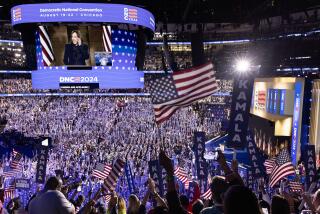COMMENTARY : NAACP’s Chavis Continues Black Leadership Tradition
- Share via
The selection of Benjamin F. Chavis Jr. as the new head of the National Assn. for the Advancement of Colored People appears to be an inspired choice.
Chavis becomes the organization’s executive director after heading the Commission for Racial Justice at the United Church of Christ. A veteran of civil rights struggles, he organized his first demonstration for civil rights when he was 13 years old. In the 1970s he served more than four years in prison after leading civil rights demonstrations in North Carolina as part of the Wilmington 10, although a federal court later overturned the conviction because it determined that police had coerced the testimony of prosecution witnesses.
Chavis’ credentials in the struggle for racial equality are impeccable, but the fact that he is an ordained minister is also significant. Jesse Jackson, a contender for the NAACP post before he withdrew from consideration at the last minute, also is an ordained minister.
This is no coincidence. Leadership within the African-American community, from the very earliest days of the United States, has always come from the ranks of ministers. Denied other expressions for leadership, the most forceful, intelligent and articulate members of the black community have been preachers.
This pattern emerged in the antebellum South. Preacher-slaves stood at the center of African-American life. They provided instruction from the Bible, but also, because some could read and write, they provided training in literacy. Even more important, they helped to boost the morale of their fellow slaves and, because black ministers often had fewer restrictions on their movements, they served as conduits of information from one slave community to the next. Occasionally, especially after the slave insurrection inspired by Nat Turner in 1831, white slaveholders tried to limit the movement of the preachers, but those restrictions had little long-term effect. The pattern had been established. Leadership among African-Americans came from the ministerial fold.
Richard Allen, for instance, led his fellow blacks out of Philadelphia’s St. George Methodist Episcopal Church in 1787 to form what eventually became the African Methodist Episcopal Church. As blacks headed to Northern cities around the turn of the 20th Century, they found a diversity of religious leaders, including Father Divine, Daddy Grace, Marcus Garvey and the Noble Drew Ali, one the progenitors of the Nation of Islam, which in turn produced Elijah Muhammad and Malcolm X as spokesmen for some African-Americans.
The leadership of the civil rights movement drew heavily from the ranks of the clergy--Vernon Johns, Fred Shuttlesworth, Chavis and, of course, Martin Luther King Jr.
As the selection of Chavis to head the NAACP confirms, the pattern of clerical leadership within the black community persists. On the strength of the Civil Rights Act of 1964 and subsequent court challenges, African-Americans have begun to win election to state and local offices, and those elected are often members of the clergy. Andrew Young, William Gray, Floyd Flake come to mind, among many others.
At least until recently, the composition of the Black Congressional Caucus in Washington consisted overwhelmingly of ministers. Jesse Jackson, a Baptist minister, made two credible runs for the presidency.
Because of the long tradition of ministerial leadership in the African-American community, black clergy have a political focus that sets them apart from white clergy and are far more likely to play a more activist social role.
The selection of Chavis to head the NAACP, then, comes as little surprise. He has proven himself as a warrior in the battle for civil rights, but he also brings with him an important badge of leadership: ordination.
More to Read
Sign up for Essential California
The most important California stories and recommendations in your inbox every morning.
You may occasionally receive promotional content from the Los Angeles Times.













